Build in Public Inspiration for Transparent Founders
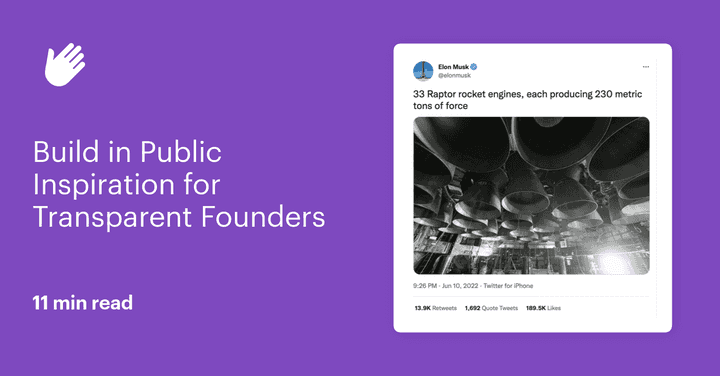
We announced our $6.5M seed round for Heyday earlier this summer. When we were drafting our press release, we hoped that coverage by a large tech publication would generate five hundred new trials. It led to fewer than twenty.
On the day we announced our funding, we decided to share our Seed pitch deck on Twitter. 300,000+ people saw our thread, hundreds signed up for a trial of Heyday, and dozens of founders reached out to for feedback on their own pitch decks.
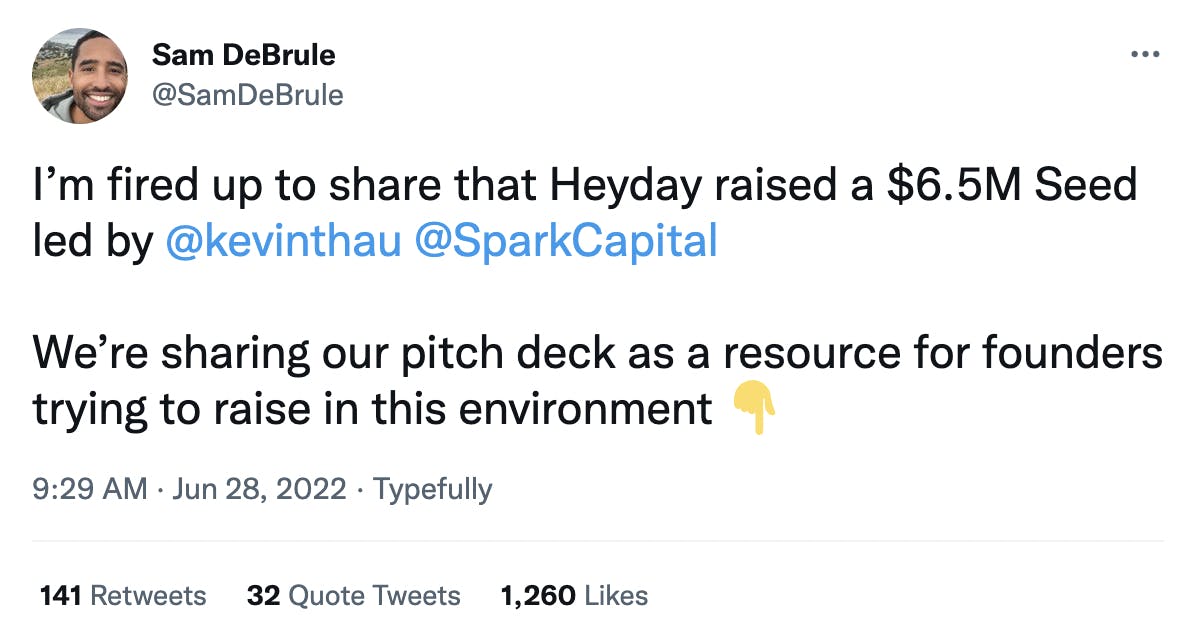
The response to our deck inspired us to share more of the “behind the scenes” of Heyday. But what else should we share?
When we couldn’t find a resource of inspiring examples from companies building in public, we decided to create it ourselves.
Why build in public?
Kevon Cheung, creator of Build in Public Mastery, defines building in public as the process of “building a company, a product, or anything and sharing a lot of the "behind the scenes" with a public audience.”
The goal of people who build public is typically one of the following (or all three!):
- acquire customers
- grow your brand
- improve your product
The response to our pitch deck on Twitter showed us that we can interact with a large audience by sharing our inner workings — not buttoned-up material.
Is building in public a fad?
It might come as a surprise, but the concept of building in public isn’t a new one.
Back in 2014, Ryan Hoover, the co-founder of Product Hunt, wrote about the benefits of building in public. And one year before that, Buffer shared one of the most awesome examples of building in public to date with their open salaries.
We think building in public will last because of the benefits it offers to both audiences and creators.
- Building in public engages people on their terms. People who build in public successfully understand that most people are on social media to be entertained — not sold a product or service.
- People are more invested when they feel involved. Would you be more likely to use a buggy product built by a stranger? Or one built by a founder you care about and want to succeed? By sharing the inner workings of your creation, you’ll make people feel more involved in your project.
- The content is unique. People create repetitive, uninteresting content when they write about subjects they know little about. People building publicly create unique content because they share their specific experiences creating something they know well.
Can building in public work for you?
A quick search on reddit for building in public turns up many questions along the lines of ”what if I fail?”
It’s normal to be filled with doubt at the beginning of any new project, but Nathan Barry, the founder of ConvertKit, believes it’s impossible to fail when building in public because it benefits both the creator and her audience.
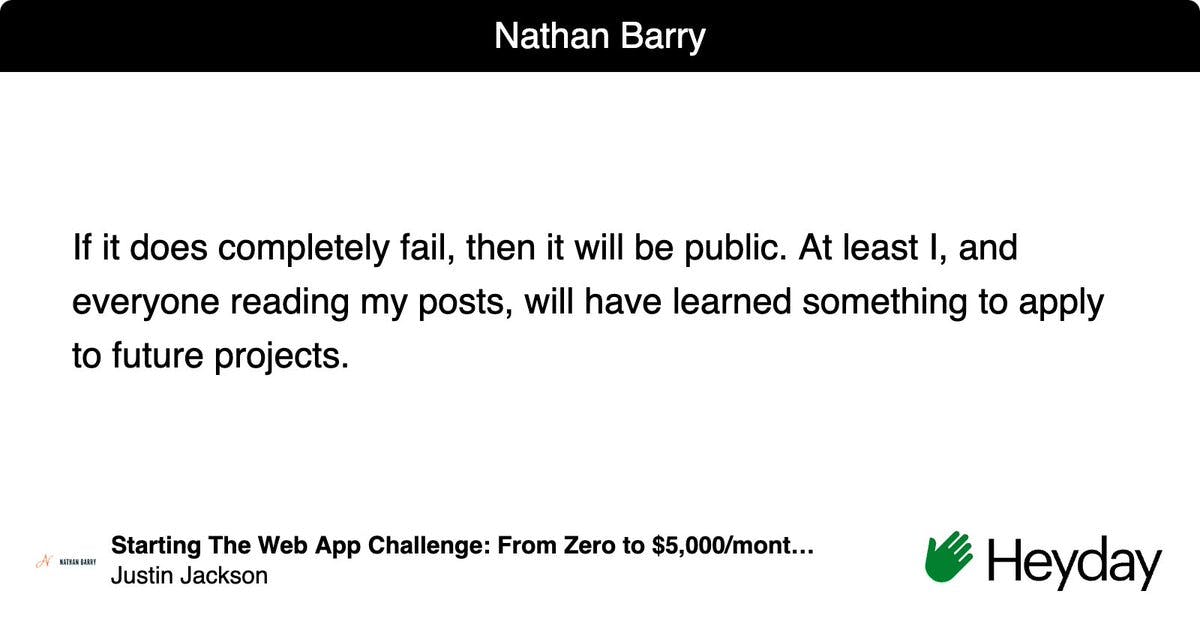
A few questions before you start:
- Who are you building for? Your target audience informs which parts of your story to share, the channels and communities where you share, and the medium of your content.
- What are you creating? A newsletter about the Parisian tech ecosystem? A rocketship that delivers supplies to the International Space Station? A chrome extension that improves memory? A documentary about an Australian comedy group? You can create standout content by leaning into things that make you and your product/service special.
- Where does your audience hang out? It’s possible for too few people to see what you’re building, even if you’re doing it publicly. Instead of trying to build a new community from scratch, try to find places where your audience is already gathering. That could be in an online community like a subreddit or a hashtag on Twitter. It could be at industry events or writer groups.
- How much will you share? There is a spectrum of building in public. People and companies on the most transparent end of the spectrum will share things like revenue metrics and internal company strategies. On the other end, you’ll see exclusively positive customer testimonials. Your answer depends on what you’re comfortable sharing and what you think your audience will like to see.
- How will you measure performance? What is most important to you? Signups? Subscribers? Followers? Bugs identified? New features suggested? Set a goal tied to your most important metric to keep yourself honest and focused while you experiment.
And finally, what content will you share?
Don’t worry if nothing comes to mind. We’ve collected dozens of examples from people building in public to get your creative juices flowing.
Building in Public Examples
Internal Process
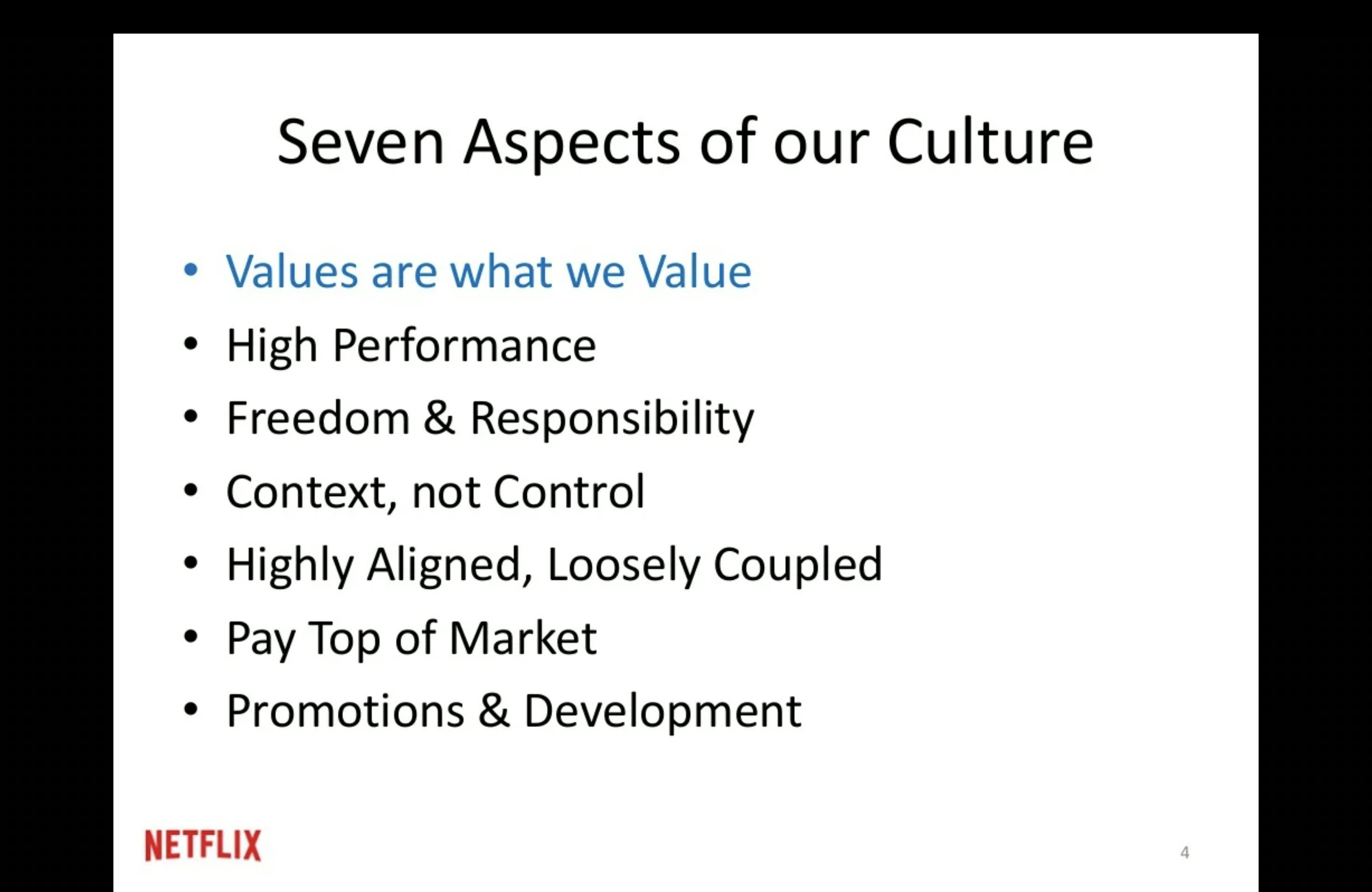
- Netflix Culture - Netflix shares the aspects of its culture that help them achieve excellence
- The GitLab Team Handbook - Gitlab CEO Sid Sijbrandij and his team share the central repository of information they use to run their multi-billion dollar company.
- From first line of code to frontpage of Reddit - Legendary public builder Pieter Levels streamed the entire process of building his startup on Twitch.
- How Canny built a $1m ARR SaaS startup - Canny CEO Sarah Hum shares how her small but mighty team grew the company to $1M ARR from inbound channels.
- In 83 days, I took the newsletter from 0->1000 subscribers - First 1000 newsletter creator Ali Abouelatta shares everything that did (and didn’t work) on his journey from 0 to 1000 newsletter subscribers.
- Buffer Transparent Salaries - Buffer shares the salaries of everyone who works at the company.
- Monzo Growth - Monzo Co-founder Tom Blomfield shares how he got customers to sign up in the early days of his company and passed 1 million customers.
- A Bootstrapped SaaS Journey to $10K MRR - Bannerbear co-founder Jon Yongfook shares the pivots, features, pricing, and positioning changes that led his company to the revenue milestone.
- How Many Trials Should I Be Getting for My SaaS - Transistor CEO Justin Jackson shares the process they used to get their distribution model right.
- How We Started 2021 Shipping 1 Product Per Week - Tabio, creator of Tweet Hunter and Taplio shares the process they built in response to working on a product that didn’t solve a real problem for years
- How I bootstrapped and sold my advertising agency - Marketing Max, a serial entrepreneur who built and sold an award-winning 7--figure ad agency, shares the painful lessons he learned during the process.
Product Development
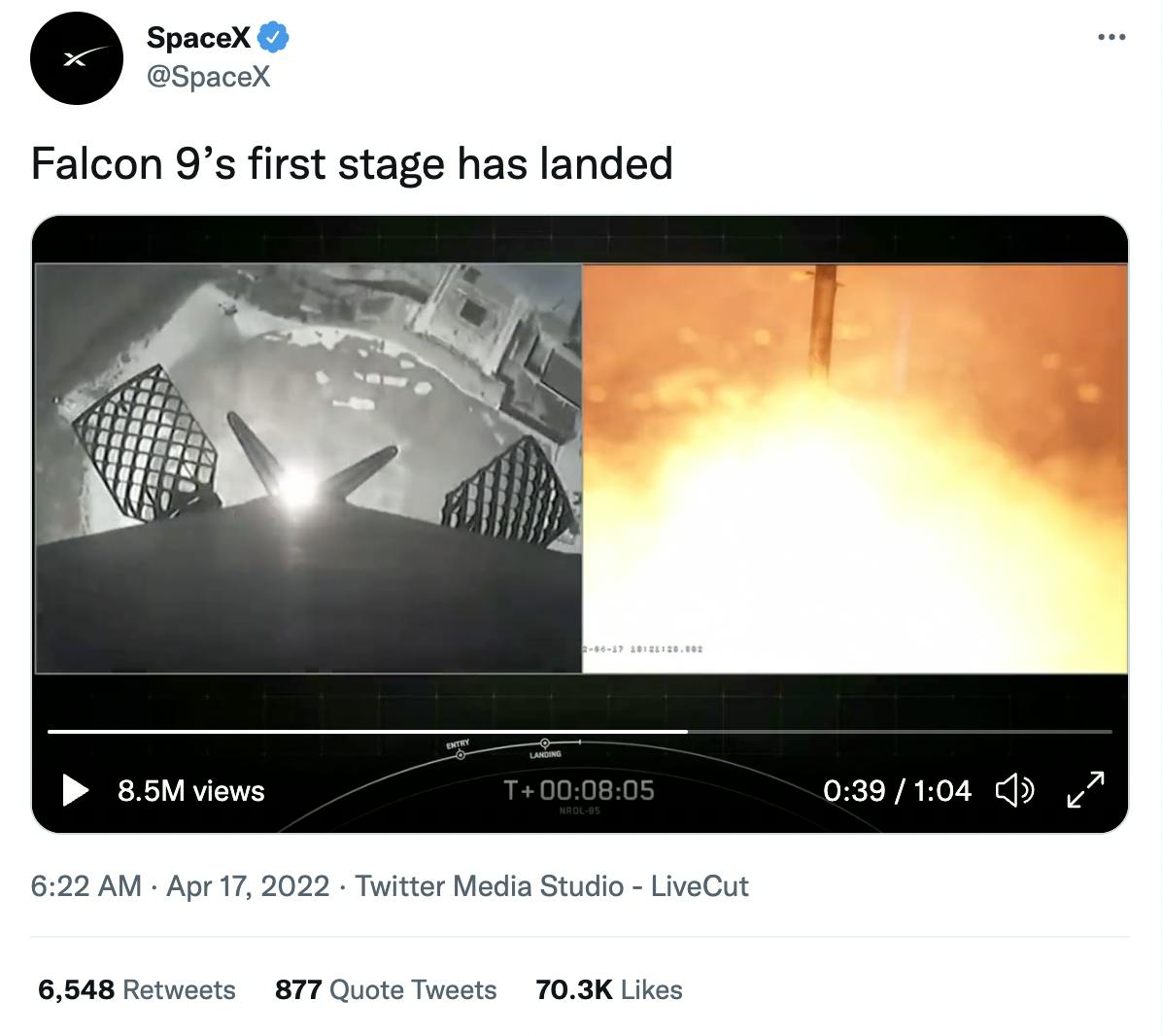
- Falcon 9’s first stage has landed - SpaceX shares live takeoff and landing footage of their rockets publicly.
- Loom, GitHub, and Front’s Product Roadmap- These three companies share the upcoming features of their products.
- Calm Company Fund Roadmap - Calm Company creator Tyler Tringas shares his fund's strategy to help founders build profitable businesses.
- Product Hunt Comment System Mockup - Product Hunt Creator Ryan Hoover shares product mockups to get feedback on a new feature before it went live.
- PoC to detect free parking spots - Igor Krasnik shares a proof of concept his team built before the product went live.
- Grow Simple Modern from 0 to 15 Million Units - Bryan Porter shares the dtc marketing strategy they used to acquire customers from Amazon and create a differentiated product.
- My dashboard needs some love - Felix Scholz shares a mockup of a new feature to collect feedback ahead of giving it to users.
- Finding products to sell on Amazon - Kobe Gatsby shares his tips on how to find big problems and sell the solution profitably on Amazon.
Personal Growth
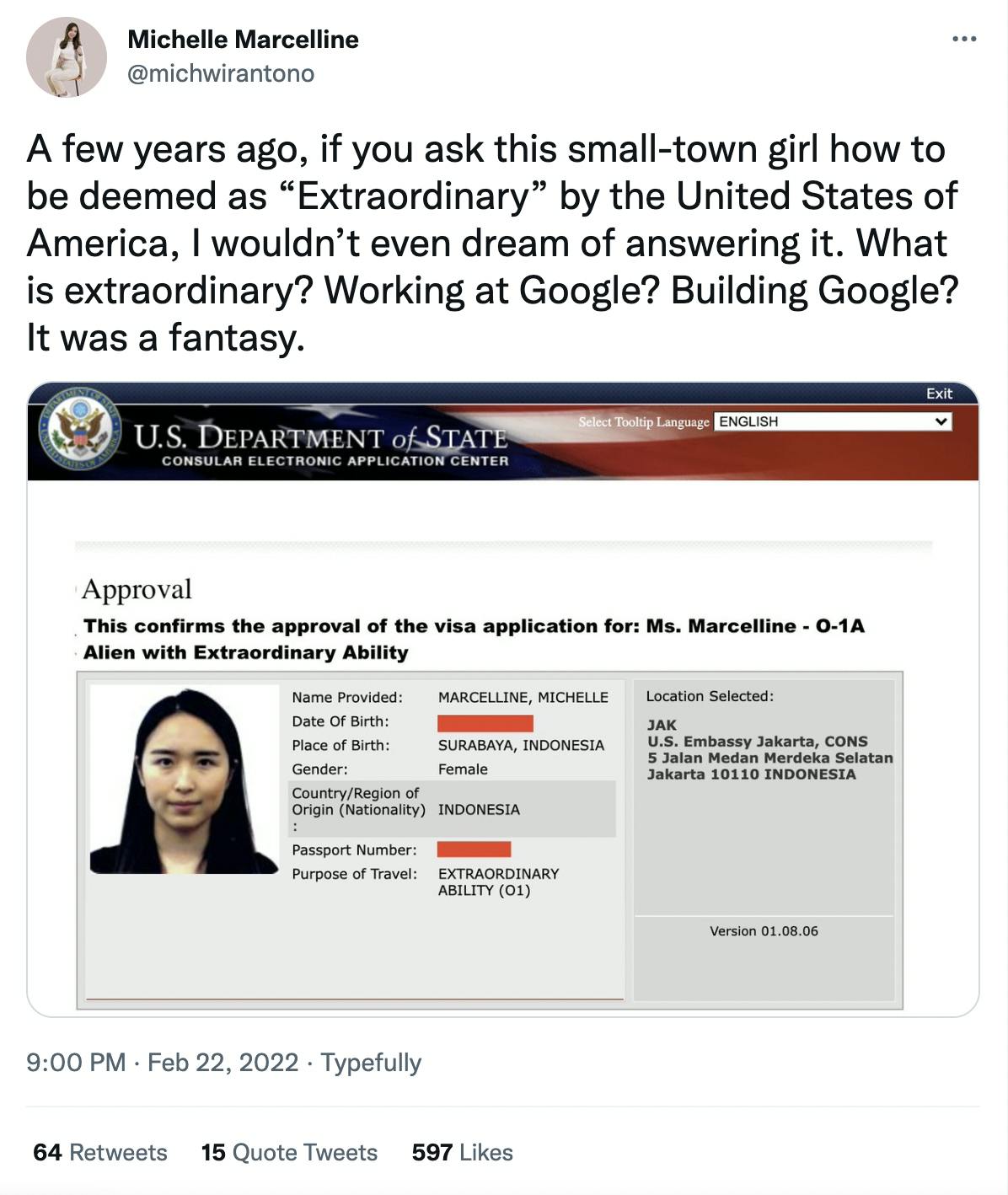
- “Why are you extraordinary?” - Michelle Marcelline, founder of Typedream, shares her story of emigrating from Indonesia to the US and her extraordinary accomplishments along the way.
- From Comments to Landing a job at Product Hunt - Sharath, a legendary community builder, shares the path that led him to land a job at Product Hunt.
- Finding a Therapist - Transistor Co-founder Justin Jackson speaks openly about the important decision of finding a counselor.
- I spent 2 years building a community remotely through cold outreach. - Behind Genius Ventures founding partner, Paige Finn Doherty, shares the framework she used to build a powerful network from scratch.
Customer Communication
- Shooting My Shot at Gary Vaynerchuk - Community builder and Build in Public evangelist KP tries to get Gary Vee on his podcast, all in public tweets.
- Typeform Breach - Monzo CEO Tom Blomfield shares a full breakdown of customers that were affected by a data breach.
- Avoiding scams on Upwork - Jake Victor, founder of Copy Eden, shares his "hellish" experience of being scammed by a client after moving their relationship off of Upwork.
Customer Feedback
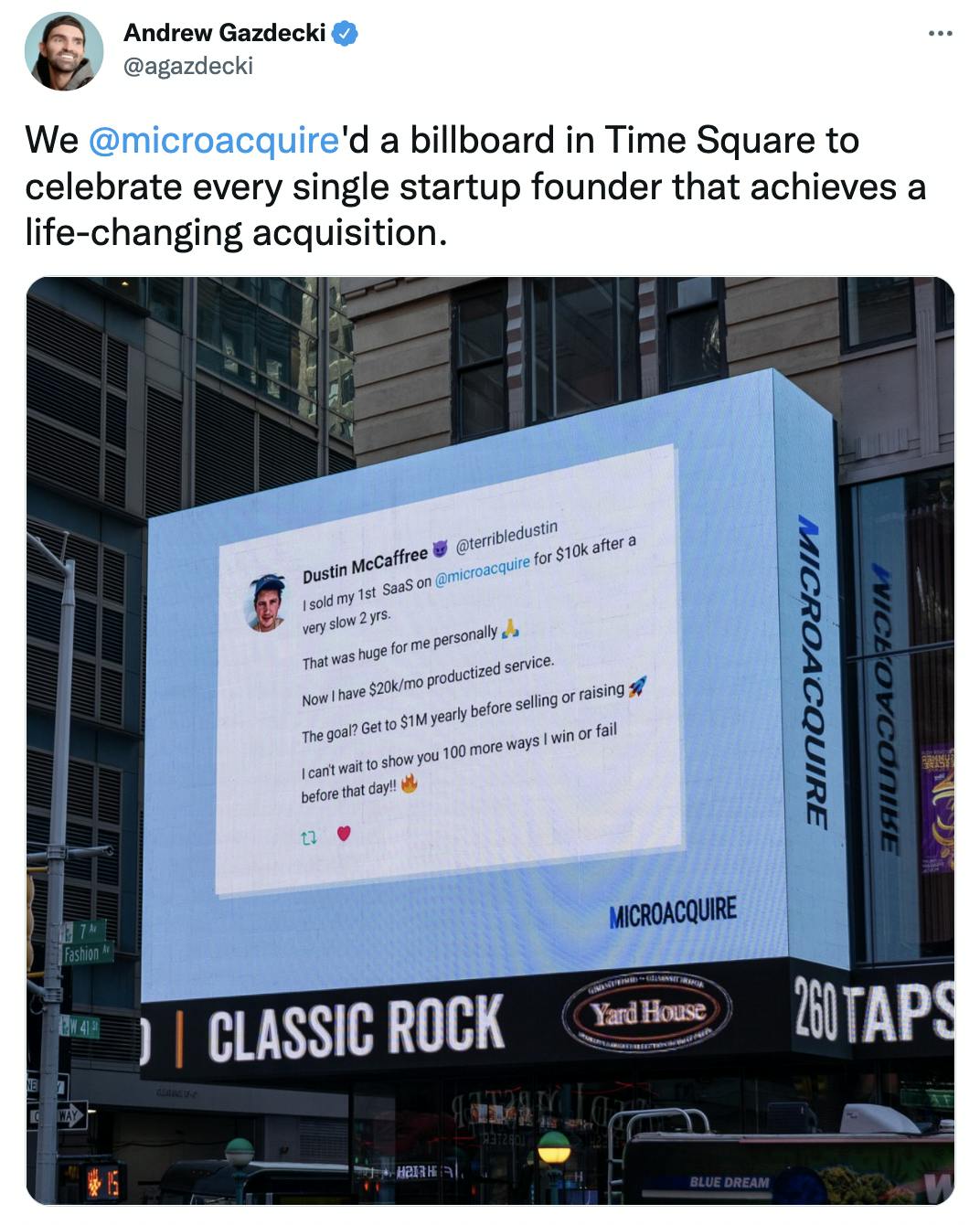
- MicroAcquire Times Square Billboard - MicroAcquire CEO Andrew Gazdecki celebrates successful founders with a public billboard.
- Student Enrolled in BloomTech directly after High School - BloomTech CEO Austen Allred shares Slack messages with one of his students.
Goals
- Starting The Web App Challenge: From Zero to $5,000/month In 6 Months - ConvertKit CEO Nathan Barry publicly challenges himself to go from no idea to a money-generating product in months.
- Kevon Cheung’s 2022 Goals - Build in Public expert Kevon Cheung shares his professional and personal goals for the world to see on Twitter.
- My process to fine-tune the vision for the littles - Wil Lee shares the steps he learned to craft a vision (and the pitfalls to avoid)
Metrics
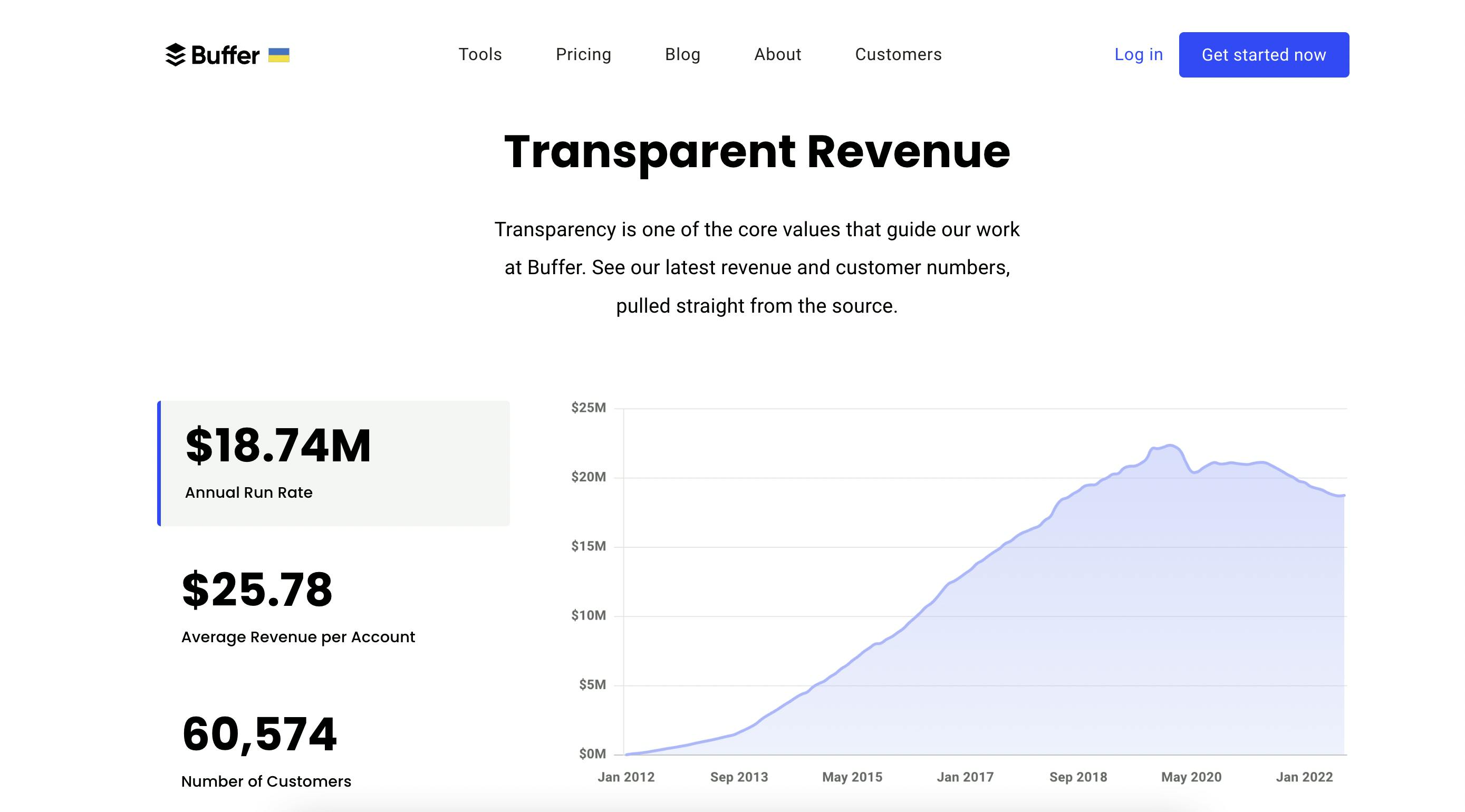
- Buffer Revenue Dashboard and Diversity Dashboard - Buffer, one of the OGs in the transparency movement, share its most up-to-date revenue, customer, and diversity & inclusion numbers.
- Nomad List Company Dashboard - Pieter Levels’ Nomad List is a fully transparent company that even makes its revenue and P&L statement public in a dashboard that anyone can see.
- Heyday’s $6.5M Seed Pitch Deck - Heyday co-founders Sam DeBrule and Samiur Rahman share the metrics and progress that enabled them to raise their seed round from top investors.
- Validation for Rosieland 2.0 - Rosie Sherry shares the content and customer numbers that validated her hypothesis to build the next version of her community platform.
- It took 716 days and 139 featured setups for Workspaces to hit 5,000 subscribers - Ryan Gilbert, creator of the Workspaces Newsletter, debunks the myth of overnight success with his subscriber growth metrics.
- Baremetrics Control Center - Baremetrics founder Josh Pigford shared his company’s financials in a public dashboard.
- Front’s Series A Slide Deck - Front’s CEO Mathilde Collin breaks down the slide deck her company used to raise their Series A.
- Growth of Highly Engaged Mighty Users - Mighty CEO Suhail Doshi shares the results of shipping daily and talking to users.
- Ghost - Company Metrics - Ghost CEO John O’Nolan shares all of his company's customer metrics in a public dashboard.
- Famewall Ramen Profitability - Goutham Jay shares the journey that he took to generate $63 MRR for his SaaS startup as a solo founder.
Stakeholder Updates
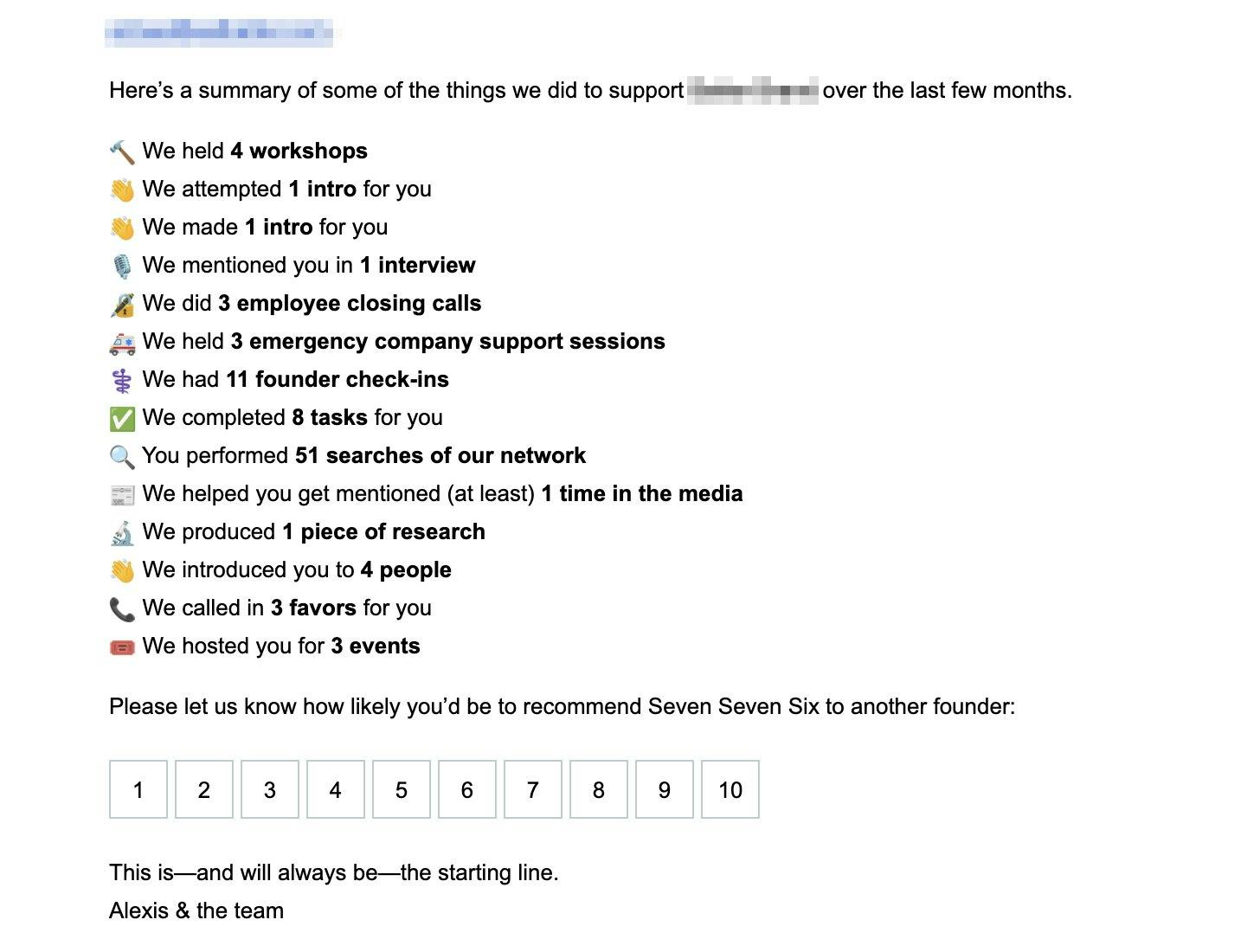
- SEVEN SEVEN SIX Founder Recap - Alexis Ohanian shares all the things they did to support founders.
- Gumroad Q1 2021 Open Board Meeting - Gumroad CEO Sahil Lavingia did a live version of his board meeting on YouTube and Clubhouse.
- Copy.ai Update August ‘21 - Copy.ai Founder Paul Yacoubian shares monthly traction, product, team, and usage stats that would typically be shared in an investor update.
- Reform Investor Update - Reform CEO Peter Suhm shares the not-always-enjoyable realities of writing investor updates.
Year in Review
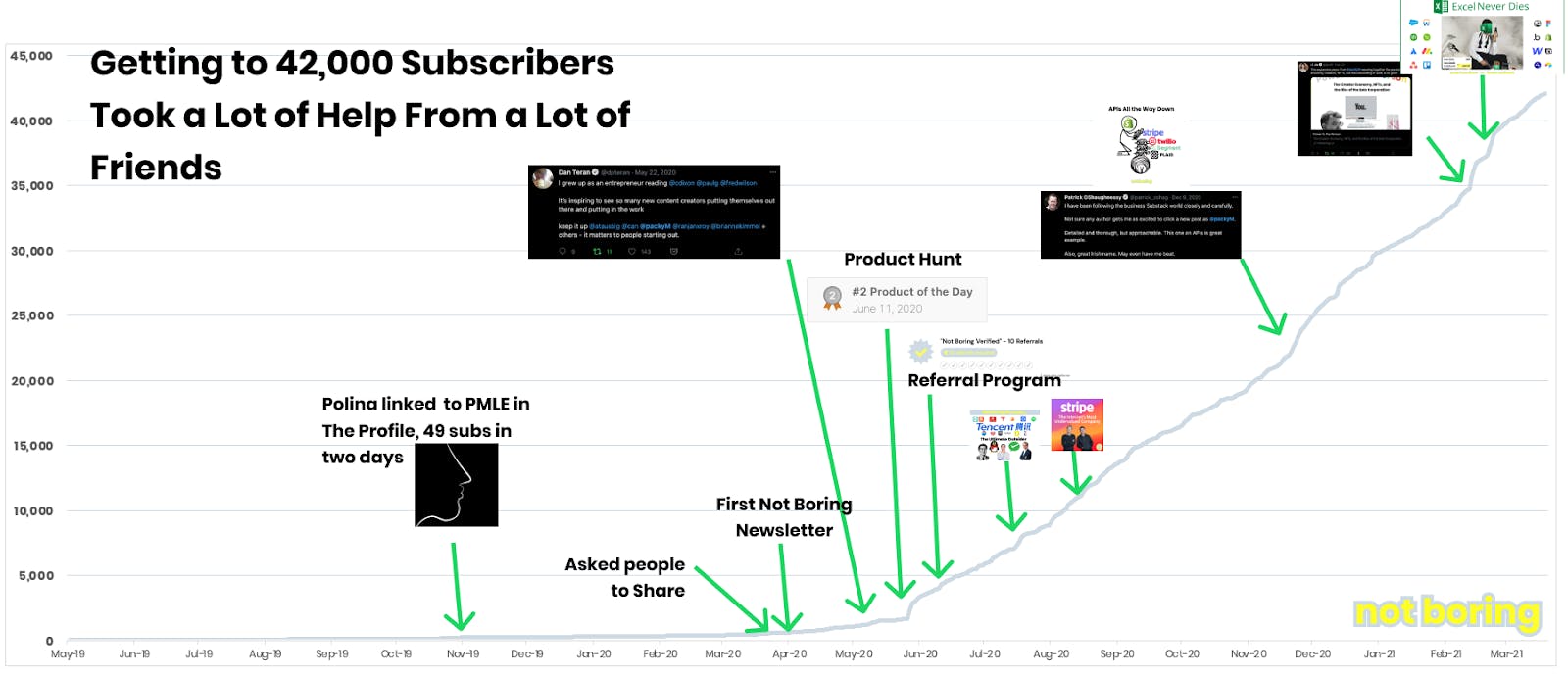
- A Not Boring Adventure, One Year In - investor and newsletter creator Packy McCormick shares from behind the scenes of the “wildest and most rewarding year of [his] life.”
- 🥳 Feeling '22 - Startup ROI creator Kyle O’Brien reflects on the steady climb of building the audience for his newsletter.
What did we miss?
There are many more inspiring examples of building public than we grabbed for this piece. If you have an example of building your own project in public, or you’ve seen another example that inspires you, ping @samdebrule on Twitter.
We’ll add your suggestion to this post and give you a shoutout too.
Building Heyday in Public
We’re early in our building in our public process. We’re experimenting with the type of content and channels that we can make our journey most interesting to our audience. Here are a few of our examples so far:
- Heyday’s $6.5M seed pitch deck
- How to launch on product hunt and win #1 product of the month
- How we raised our seed round
- Our Process for Hiring Software Engineers at Heyday
- Onboarding improvements that cut our churn by nearly 300%
Doing research before you start to build in public?
Heyday will save you time and help you retain more of what you learn.